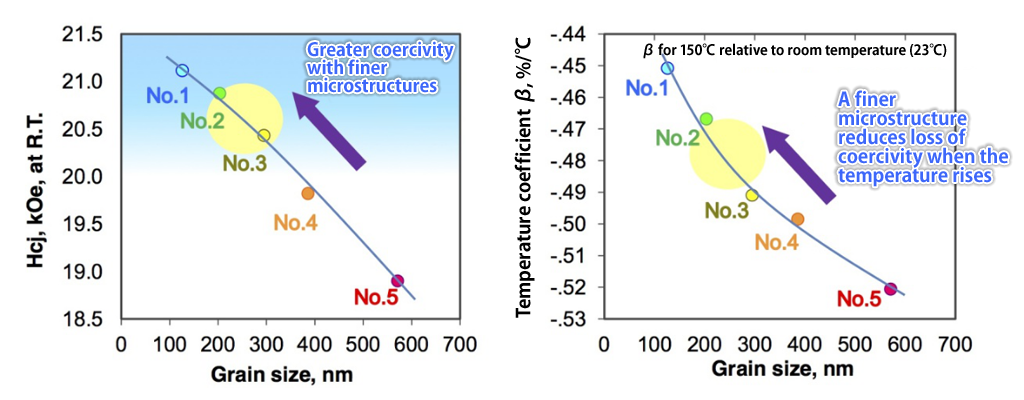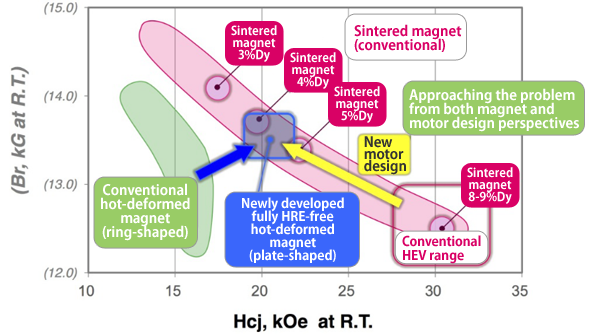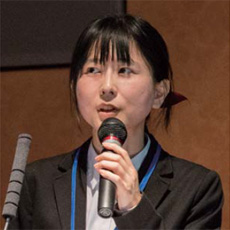Development of Heavy-Rare-Earth-Free Hot-Deformed Nd-Fe-B Magnets and Their Practical Realization for Traction Motors
-

-

- Experiment

-

- Carrying out development that utilizes the features of hot-deformed magnets
- Realizing mass-production of plate magnets suited for traction motors in hybrid electric vehicles (HEV)
- Realizing an HEV traction motor that is free of heavy-rare-earth elements by integrating magnetic materials development with motor design technologies
The Need for Heavy-Rare-Earth-Free Magnets
As electric vehicles increase in popularity, the demand for neodymium magnets used in their motors will skyrocket. Moreover, since heavy-rare-earth elements (HREEs) are added to neodymium magnets according to their operating environment, the demand for such HREEs will likely increase at a staggering rate. This is problematic because the most profitable mines for HREEs are disproportionately located in China and mining these elements has a heavy impact on the environment. The development of HRE-free magnets is just one of the many efforts being implemented under these circumstances.
Realization of practical mass production wholly free of heavy-rare-earth elements
We succeeded in achieving mass production of hybrid automobiles that use no HREEs by integrating the development of magnetic materials with motor design technologies possessed by Honda R&D Co., Ltd.
While it is currently popular to use sintered neodymium magnets, our development utilized the properties of hot-deformed magnets. Hot-deformed magnets are advantageous in that they have finer crystal grains that improve heat-resistance without relying on HREEs. However, with the use of conventional technologies it is not possible to mold magnets into the plate form that is commonly used in traction motors. Further, in terms of their properties, the magnets suffer from insufficient coercivity.
While neodymium magnets possess fine microstructures, we succeeded in producing magnets with finer microstructures by controlling their molding conditions, which resulted in improved heat resistance (Figure 1).
By conducting structural analysis while modifying the size of the grain boundary phase, it became apparent that adjusting the thickness of the grain boundary phase of the magnet is effective for improving coercivity. While proof of this phenomenon has been long-anticipated, we were able to verify it through recent advances in observation technologies.
Further, our findings from studying the composition of grain boundary phases revealed that coercivity is higher when the composition of the grain boundary phase is rich in neodymium or, put another way, when the composition has a lower iron ratio. It seems likely that the greater magnetic isolation between crystal grains is a factor in the improved coercivity.
With respect to the shape of the magnets, our latest study succeeded in making viable the mass production of plate magnets for use in the traction motors of hybrid vehicles (Figure 2). The motor developed by Honda R&D Co., Ltd. in this study reduces the opposing magnetic field acting on the magnet through new designs of the magnet’s shape and the rotor’s structure. An analysis of magnetic fields in the newly designed motor revealed that demagnetization does not occur.
After succeeding in molding plate magnets with hot-deformed magnets in this phase of the development we were able to achieve practical mass production of magnets entirely free of HREEs by controlling the grain boundary phase, achieving properties equivalent to sintered magnets containing 4–5 wt.% of dysprosium (Figure 3).
Continuing to set high goals for required properties
Traditionally, magnets required for HEV traction motors contained 8–10 wt.% of dysprosium. With the recent movement to curtail the use of HREEs, research has shifted direction toward high Br and low coercivity. These objectives are achieved by enhancing the cooling capacity of the motor, improving the magnetic circuit, and increasing the magnet’s thickness.
In our future endeavors, we intend to continue raising the bar on performance requirements to achieve such goals as reducing cost while achieving properties equivalent to conventional magnets, strengthening magnetic force in order to reduce the motor size while maintaining coercivity, and increasing coercivity in order to improve heat resistance while minimizing the risk of resource depletion.

Figure 1 Increased coercivity and improved temperature characteristics through control of fine crystal grain microstructures

Figure 2 The newly designed motor (rotor) and an HRE-free Nd-Fe-B magnet

Figure 3 An HRE-free motor

Keiko Hioki
Daido Steel Co., Ltd.